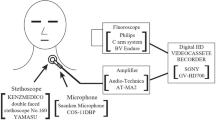Abstract
Velar motion for dry and liquid swallows was investigated. as well as velar activity in speech, based on X-ray microbeam pellet tracking data. Electromyographic recordings for tensor and levator veli palatini were obtained simultaneously. Velar pellet trajectories for swallowing were more complex than for speech, since there was a highvelocity anterior component in swallowing. For some swallows this anterior component was integrated with velar elevation (especially in liquid swallows), but in other cases initial velar elevation occurred considerably earlier (chiefly in dry swallows). The burst of tensor and levator veli palatini activity characteristic of swallowing was associated with the anterior component of velar pellet motion, but not consistently with velar elevation per se. The conventional view on timing of tensor veli palatini contraction in a swallow, which governs Eustachian tube opening, is that this is associated with velar closure. The X-ray microbeam data suggest rather that Eustachian tube ventilation is more closely associated in time to the onset of pharyngeal peristalsis, which may or may not coincide with initial velar elevation.
Similar content being viewed by others
References
Rich AR: A physiological study of the Eustachian tube and its related muscles.Bull Johns Hopkins Hosp 31:206–214, 1920
Salomon G, Starr A: Electromyography of middle ear muscles in man during motor activities.Acta Neurol Scand 39: 161–168, 1963
Honjo I, Okazaki N, Kumazawa T: Experimental study of the Eustachian tube function with regard to its related muscles.Acta Otolaryngol 87:84–89, 1979
Cantekin E, Doyle W, Reichert T, Phillips D, Bluestone C: Dilation of the Eustachian tube by electrical stimulation of the mandibular nerve.Ann Otol Rhinol Laryngol 88:40, 1979
Rood SH, Doyle WJ: The nasopharyngeal orifice of the auditory tube: implications for tubal dynamics anatomy.Cleft Plate J 19:119–128, 1982
Seif S, Dellon AL: Anatomic relationships between the human levator and tensor veli palatini and the Eustachian tube.Cleft Palate J 15:329–336, 1978
Fritzell B: The velopharyngeal muscles in speech.Acta Otolaryngol Suppl (Stockh.) 250, 1969
Basmajian JV, Dutta CR: Electromyography of the pharyngeal constrictors and levator palati in man.Anat Rec 139: 561–563, 1961
Palmer JB, Tanaka E, Siebens A: Motions of the posterior pharyngeal wall in swallowing.Laryngoscope 98:414–417, 1988
Doty RW, Bosma JF: An electromyographic analysis of reflex deglutition.J Neurophysiol 19:44–60, 1956
Shipp T, Deutsch WW, Robertson K: Pharyngoesophageal muscle activity during swallowing in man.Laryngoscope 80: 1–16, 1970
Matsumoto H: X-ray TV cinematological and electromyographical studies on positional changes of the hyoid bone.Shika Gakuho 77:533–544, 1977
Yoshida T: Electromyographic and x-ray investigations of normal deglutition.Otologia (Fukoka) 25:824–872, 1979
Perlman A, Grayhack JP: Electromyographic activity in laryngeal and pharyngeal muscles during normal deglutition.ASHA 32:72, 1990
Kuehn DP, Folkins JW, Cutting CB: Relationships between muscle activity and velar position.Cleft Palate J 19:25–35, 1982
Bell-Berti F, Hirose H: Palatal activity in voicing distinctions: a simultaneous fiberoptic and electromyographic study.J Phonetics 3:69–74, 1975
Lubker JF: An electromyographic-cinefluorographic investigation of velar function during normal speech production.Cleft Palate J 5:1–18, 1968
Seaver EJ, Kuehn DP: A cineradiographic investigation of velar positioning in nonnasal speech.Cleft Palate J 17:216–226, 1980
Honjo I, Ikazaki N, Nozoe T: Role of the tensor veli palatini muscle in movement of the soft palate.Acta Otolaryngol 88: 137–141, 1979
Hamlet S: Dynamic aspects of lingual propulsive activity in swallowing.Dysphagia 4:135–145, 1989
Westbury JR: Head position during x-ray microbeam experiments: its significance and measurement.J Acoust Soc Am 89:1782–1791, 1991
Shprintzen RJ: A three-dimensional cinefluoroscopic analysis of velopharyngeal closure during speech and non-speech activities in normals. Dissertation, Syracuse University, NY, 1973
Robbins JA, Logemann JA, Kirshner HS: Swallowing and speech production in Parkinson's disease.Ann Neurol 19: 283–287, 1986
Dantas RO, Dodds WJ, Massey BT, Shaker R, Cook IJ: Manometric characteristics of glossopalatal sphincter.Dig Dis Sci 35:161–166, 1990
Rubesin SE, Jones B, Donner MW: Radiology of the adult soft palate.Dysphagia 2:8–17, 1987
Smith D, Hamlet S, Jones L: Acoustic technique for determining timing of velopharyngeal closure in swallowing.Dysphagia 5:142–146, 1990
Curtis DJ, Cruess DF, Dachman AH, Maso E: Timing in the normal pharyngeal swallow.Invest Radiol 19:523–529 1984
Perlman AL, Luschei ES, DuMond CE: Electrical activity from the superior pharyngeal constrictor during reflexive and nonreflexive tasks.J Speech Hear Res 32:749–754, 1989
Azzam NA, Kuehn DP. The morphology of musculas uvulae.Cleft Palate J 14:78–87, 1977
Maue-Dickson W, Dickson DR: Anatomy and physiology related to cleft palate: current research and clinical implications.Plast Reconst Surg 65:83–90, 1980
Miller AJ: Neurophysiological basis of swallowing.Dysphagia 1:91–100, 1986
Sessle BJ, Henry JL: Neural mechanisms of swallowing: neurophysiological and neurochemical studies on brain stem neurons in the solitary tract region.Dysphagia 4:61–75, 1989
Hamlet S, Jones L, Mathog R, Bolton M, Patterson R: Bolus propulsive activity of the tongue in dysphagic cancer patients.Dysphagia 3:18–23, 1988
Dodds, WJ, Logemann JA, Stewart ET: Radiologic assessment of abnormal oral and pharyngeal phases of swallowing.AJR 154:964–974, 1990
Author information
Authors and Affiliations
Additional information
This work was supported by the National Institutes of Health under grant no. NS-16373 (NINCDS) and grant no. CA-43838 (NCI).
Rights and permissions
About this article
Cite this article
Hamlet, S.L., Momiyama, Y. Velar activity and timing of eustachian tube function in swallowing. Dysphagia 7, 226–233 (1992). https://doi.org/10.1007/BF02493474
Issue Date:
DOI: https://doi.org/10.1007/BF02493474




